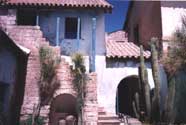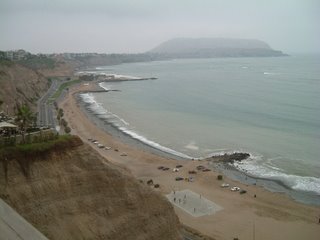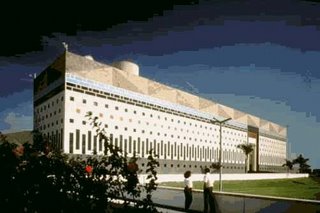I just got back from another weekend on the island of Amantani. The community of Suncayani Alto welcomed me with open arms... 80 little arms to be exact. We are trying to develop this project with an emphasis on having Puno's local university students take the iniative in volunteering. Unfortunately, folks were a tad too busy this weekend partying. I must admit, I was a tad upset that no one would take the time to travel for a day to the island. One of my to-be companions showed up at the house around 1pm...a bit late seeing as the boat leaves at 8am on the dot. So I was alone to receive the hugs from the island's children.
After settling in Silverio's house and having lunch with two very shy Swiss tourists, I was off to the community's school. I hoped to meet roughly 20 kids, as that had been a relatively manageable number last weekend. Not surprisingly, word had spread about the activities and books that I had brought last Saturday. I was confronted with 40 VERY animated kiddies. We played a couple of games that drew lots of giggles. Afterwards (and I am still amazed about this), I read an entire book to the kids and actually kept their attention! Even better...the kids understood the story after I asked them some comprehension questions.
After finishing the story of Pinochio, I asked them what special tool the fairy used to turn Pinochio into a real boy. "A magic wand!" the kids exclaimed. "Very good!" I told them "Now, I don't have any magic wands, but today I have a very special magic box for you all." In my special box were 50 pieces of colored chalk. Each child got to pick the color of the chalk and draw the different characters from the story. They wrote the names of the characters and drew Geppeto, the fairy, the fox, the cat. One boy even copied the image of Geppeto and Pinochio in the boat fleeing the angry whale. This wasn't enough for the kids, and they wanted to draw more characters....Little Red Riding Hood and the wolf, Alice in Wonderland and the rabbit. Within an hour the entire patio was filled with blue, yellow, red, and brown images and words. Let me tell you...there were a LOT of mean-looking whales on the school patio yesterday!!! Project chalk....accomplished and quite fun.
The rumor had spread on the island that I was going to shower the children with books, notebooks, pens, etc. The goal of our work is not to dump gifts on the population. Instead, we are trying to work with them to promote a reading culture. When I met with the parents, the proyect was clarified in this sense. They had just finished building a kindergarden for the younger students. We discussed the option of using a small portion of the center for a library. I promised to make a deal with the community. As our intent was not to simply donate things in the community and run, our group would work with the community to create the library. If the community agreed to develop a communal fund for purchasing books, materials, as well as maintaining the local, the volunteers would help with the construction and purchasing of materials to begin the library.
To anyone reading this in the U.S., if you are interested in donating to our project please let me or my mom know! The easiest way would be to send money to buy products (chalk, notebooks, books). My hope is to also gather funds to purchase a stereo and buy basic English/French/German comprehension tapes so that the families can develop basic vocabulary in order to communicate with the tourists they house.
The parents were very upbeat, and decided that they would vote on the issue in the upcoming weekly meeting. They asked me how much money the project would demand of them. I told them that a) it was not my place to make that decision, but it would be an important issue to debate in the community, and b) I recommended that they designate a small monthly fund in order to consider this project as a long-term, sustainable resource for all to enjoy. Again, the important knowledge that we as volunteers will offer is how to create a space that is respected and enjoyed by everyone in the community.
The kids and parents were a bit upset that I won't be back on the island for three weeks. While I do enjoy spending a day in Amantani, I really think it is necessary that others in our group step up and get involved. Additionally, I have made some other committments for the next two weekends to share with you all later....but here is a quick preview:
next Saturday- writing party with the kids on the floating island of Kuntiki...the kids are going to make up myths about their island. Either I will go to their island or they will come to Puno and we will go do some shopping at a book store!
following Saturday- I will be donating my fertile youth to the fields of the island of Anapia. I will be working with one of our island coordinators, Jose Flores, on his land and getting to know his community.
I left the Amantani this morning at 5am on the communal boat and arrived in Puno to shower and repack my bags. This afternoon I am heading out to the rural province of Chucuito to begin my contacts, interviews, and setting dates for my focus groups following the new year. This week, I will be staying in the city of Juli with two German theologians and working with the contacts I have made through my host institute as well as the Institute on Rural Education. I will return to the city of Puno on Friday with lots of stories and hopefully lots of interviews/meeting dates. Keep your fingers crossed!
A brief history of the Aymara in Peru
-
*IRPA’s mission is to develop and enable the productive and organizational
skills of less favoured populations in the highland region through the
managemen...
16 years ago







